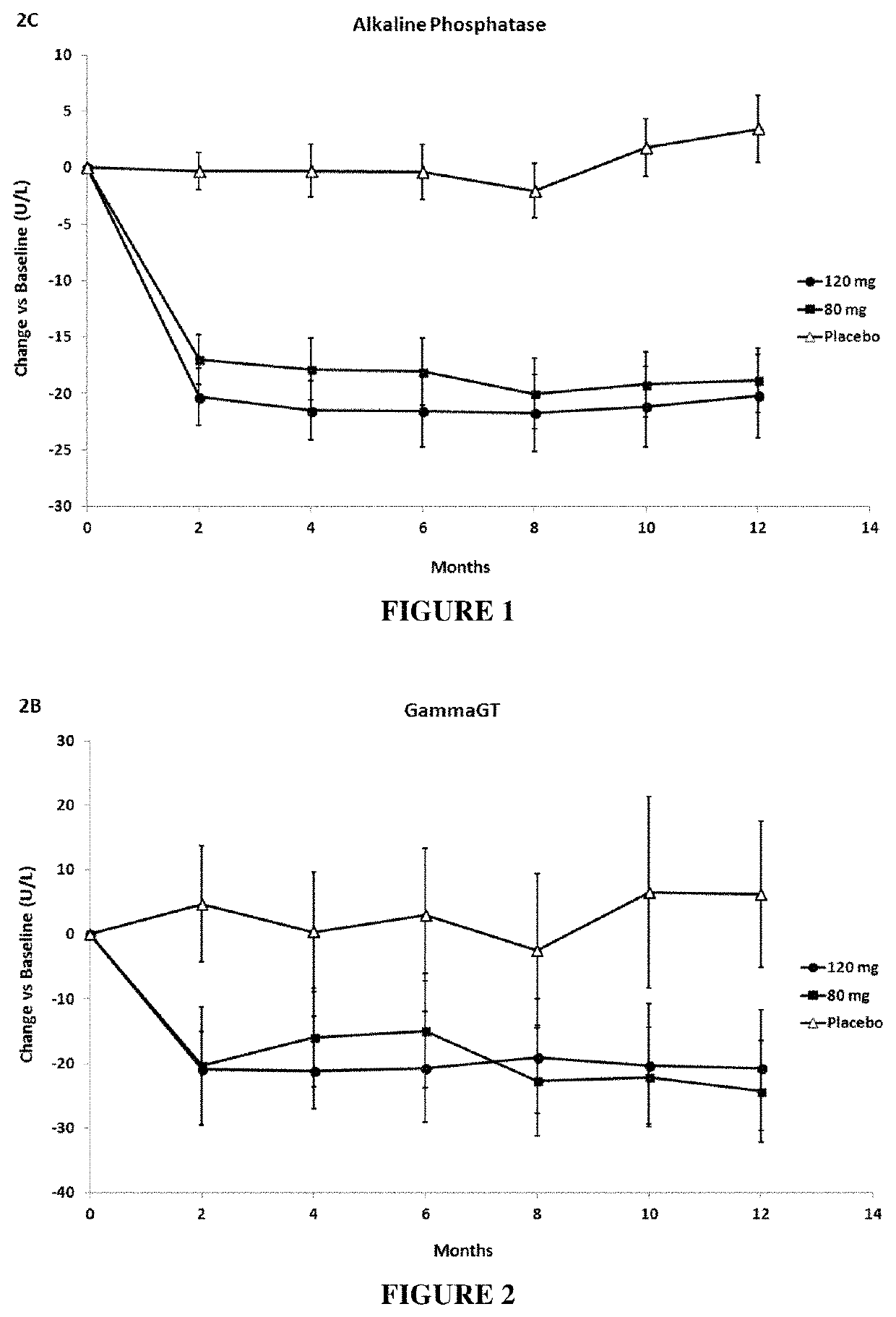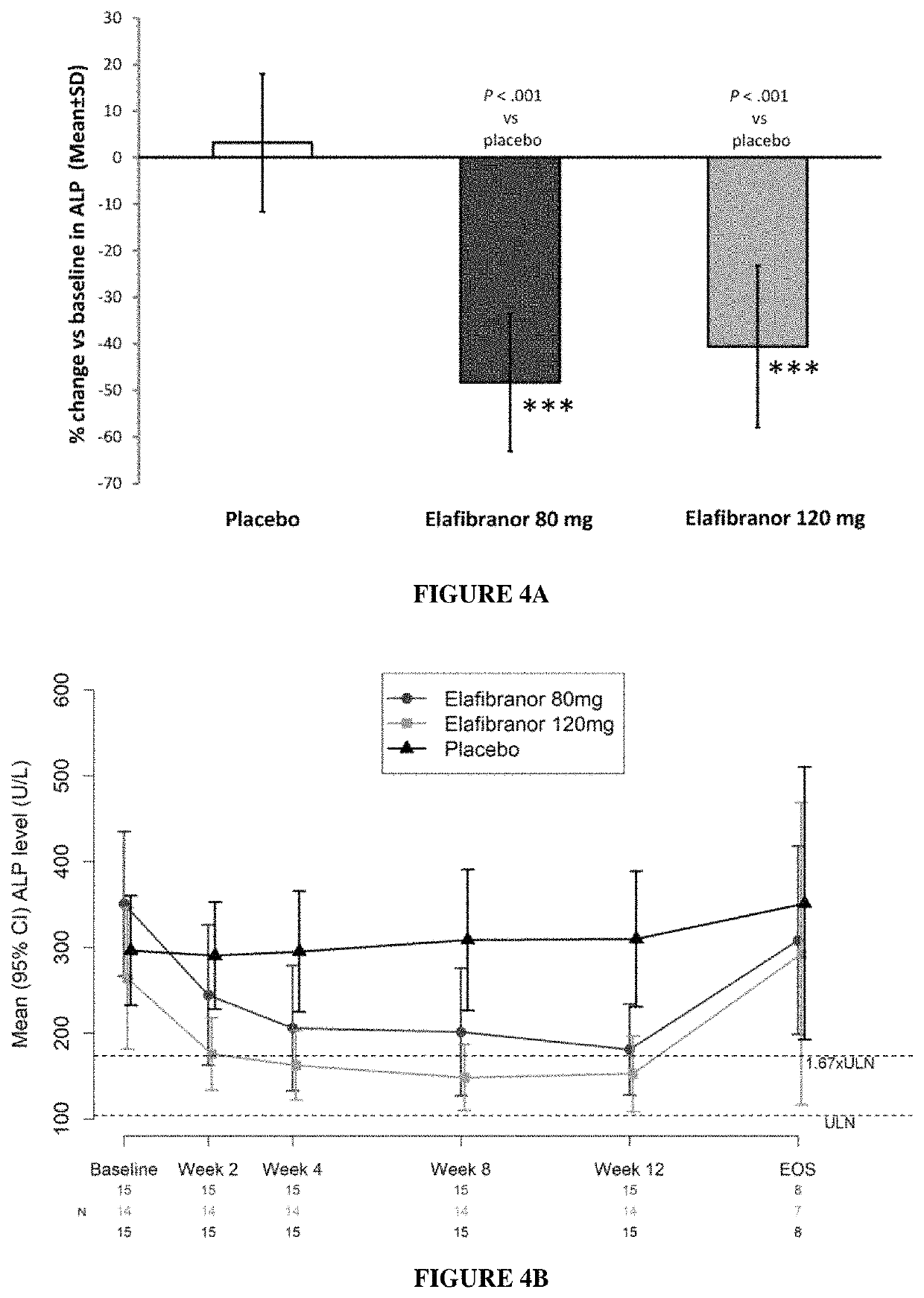Methods of treatment of cholestatic diseases
a cholestatic disease and treatment method technology, applied in the field of medicine, can solve the problems of liver failure, liver failure, etc., and achieve the effect of reducing the risk of cholestatic disease, and improving the quality of li
- Summary
- Abstract
- Description
- Claims
- Application Information
AI Technical Summary
Problems solved by technology
Method used
Image
Examples
example 1
GT Dosages
[0162]Adult subjects with non-alcoholic steatohepatitis (age 18-75 years) were treated at the dose of 80 mg and 120 mg per day of elafibranor over 52 weeks.
[0163]A total of 276 NASH patients were randomized: 92 in the placebo group, 93 in the elafibranor 80 mg group and 91 in the elafibranor 120 mg group. Two patients did not receive the study medication and the remaining 274 patients constitute the ITT (intention to treat) population. 33 patients (12%) dropped out during the study. Final liver biopsies were available in 237 patients (77, 82, and 78 patients in the placebo, elafibranor 80 mg, and elafibranor 120 mg groups respectively).
[0164]Patients were followed every 2 months with clinical and laboratory evaluations.
[0165]Patients treated with both elafibranor doses (80 mg and 120 mg) improved liver function tests (ALT, γGT and alkaline phosphatase) and lipid parameters (triglycerides, LDL-cholesterol, HDL-cholesterol).
[0166]Elafibranor lowered alkaline phosphatase (see...
example 2
[0170]The effect of elafibranor was further tested in relation to parameters more directly related to cholestatic diseases than ALP and γGT levels. Thus, it was explored whether treated subjects show a decrease in plasma total bile acids. The measurement of serum 7α-hydroxy-4-cholesten-3-one (7α-HCO, or 7αC4, or C4) is a method for monitoring the enzymatic activity of hepatic cholesterol 7α-hydroxylase, the rate-limiting and major regulatory enzyme in the synthesis of bile acids. Thus a decrease in C4 level reflects a decrease in total bile acids in the patient.
[0171]In NASH patients with high ALP level at baseline, elafibranor was orally administered at a dose of either 80 mg or 120 mg per day over 52 weeks.
[0172]A total of 62 NASH patients with high ALP levels were randomized: 23 in the placebo group, 16 in the elafibranor 80 mg group and 23 in the elafibranor 120 mg group.
[0173]Bile acids precursor levels were improved in the patients having received both elafibranor doses, in a ...
example 3
Trial for PBC
[0174]A multicenter, double-blind, randomized, placebo-controlled, phase 2 study clinical trial is conducted in patients with Primary Biliary Cholangitis and inadequate response to ursodeoxycholic acid to evaluate the efficacy and safety of treatment with elafibranor given orally (80 mg daily and 120 mg daily) for 12 weeks.
[0175]Primary Objectives
[0176]The primary objective is to compare the effect of daily oral administration of elafibranor 80 mg and 120 mg on changes in serum alkaline phosphatase (ALP) to that of placebo in patients with PBC and inadequate response to ursodeoxycholic acid (UDCA).
[0177]Secondary Objectives
[0178]The secondary objectives are:[0179]to assess the response to treatment based on composite endpoints:[0180]ALP15% decrease in ALP[0181]ALP40% decrease in ALP[0182]to assess response according to:[0183]Paris I, Paris II, Toronto I, Toronto II, UK-PBC risk score[0184]to assess response based on the percent of patients who normalized ALP[0185]to ass...
PUM
| Property | Measurement | Unit |
|---|---|---|
| MRI | aaaaa | aaaaa |
| imaging analyses | aaaaa | aaaaa |
| width | aaaaa | aaaaa |
Abstract
Description
Claims
Application Information
 Login to View More
Login to View More - R&D
- Intellectual Property
- Life Sciences
- Materials
- Tech Scout
- Unparalleled Data Quality
- Higher Quality Content
- 60% Fewer Hallucinations
Browse by: Latest US Patents, China's latest patents, Technical Efficacy Thesaurus, Application Domain, Technology Topic, Popular Technical Reports.
© 2025 PatSnap. All rights reserved.Legal|Privacy policy|Modern Slavery Act Transparency Statement|Sitemap|About US| Contact US: help@patsnap.com



